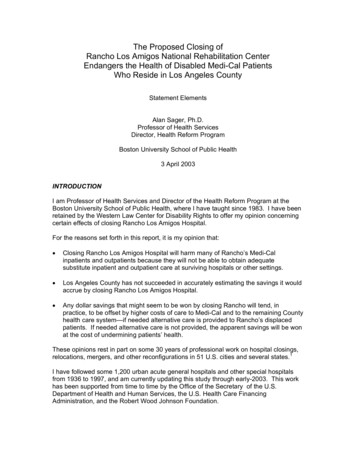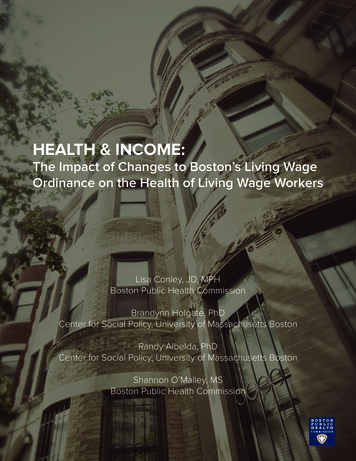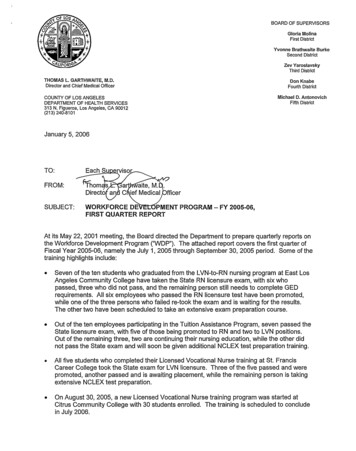
Transcription
The Proposed Closing ofRancho Los Amigos National Rehabilitation CenterEndangers the Health of Disabled Medi-Cal PatientsWho Reside in Los Angeles CountyStatement ElementsAlan Sager, Ph.D.Professor of Health ServicesDirector, Health Reform ProgramBoston University School of Public Health3 April 2003INTRODUCTIONI am Professor of Health Services and Director of the Health Reform Program at theBoston University School of Public Health, where I have taught since 1983. I have beenretained by the Western Law Center for Disability Rights to offer my opinion concerningcertain effects of closing Rancho Los Amigos Hospital.For the reasons set forth in this report, it is my opinion that: Closing Rancho Los Amigos Hospital will harm many of Rancho’s Medi-Calinpatients and outpatients because they will not be able to obtain adequatesubstitute inpatient and outpatient care at surviving hospitals or other settings. Los Angeles County has not succeeded in accurately estimating the savings it wouldaccrue by closing Rancho Los Amigos Hospital. Any dollar savings that might seem to be won by closing Rancho will tend, inpractice, to be offset by higher costs of care to Medi-Cal and to the remaining Countyhealth care system—if needed alternative care is provided to Rancho’s displacedpatients. If needed alternative care is not provided, the apparent savings will be wonat the cost of undermining patients’ health.These opinions rest in part on some 30 years of professional work on hospital closings,relocations, mergers, and other reconfigurations in 51 U.S. cities and several states.1I have followed some 1,200 urban acute general hospitals and other special hospitalsfrom 1936 to 1997, and am currently updating this study through early-2003. This workhas been supported from time to time by the Office of the Secretary of the U.S.Department of Health and Human Services, the U.S. Health Care FinancingAdministration, and the Robert Wood Johnson Foundation.
I have twice testified before committees of the U.S. House of Representatives on urbanhospital closings nationally, and have occasionally investigated or testified on individualhospital closings, relocations, and other reconfigurations in Cincinnati, Detroit,Manchester (New Hampshire), Philadelphia, Washington, D.C., in other cities, and inthe three southern New England states generally.These are some of the main findings from my 51-city study concerning causes orpredictors of hospital closings: hospitals located in African-American communities are substantially more likely toclose, decade after decade, even after controlling for other predictors of closing; hospitals that close are actually more efficient (less costly) even after adjusting forcase mix/severity of illness, than are surviving hospitals—this is not a case ofsurvival of the fittest; and larger hospitals and teaching hospitals are more likely to survive than are smallerand less specialized non-teaching hospitals.Other findings from this 51-city study concern the effects of hospital closings generally.The observed pattern of closings of acute general and other special hospitals in the 51cities appears to be associated with reductions in access to care, increases in cost ofcare, and some improvements in technical quality of care. This is because smaller,more accessible, and less costly hospitals are more likely to close, while larger, lessaccessible, and more costly teaching hospitals are likelier to remain open.Most Americans believe that a functioning free market is almost always the best methodof making important economic decisions. I strongly lean in that direction. Unfortunately,for a host of reasons, we do not seem to enjoy the benefits of a free market system inurban hospital care—a system that would weed out the inefficient and less neededhospitals.Rather, it appears that a considerable number of needed and relatively low-costhospitals are forced to close. The overall configuration of hospital care has apparentlybeen changed in some ways that are markedly undesirable—less accessible and morecostly. Entire districts of large cities are without hospitals today. The northern half of St.Louis, extensive parts of Philadelphia, and the eastern half of Washington, D.C., forexample, are entirely lacking in hospitals or almost entirely lacking. The harm is notrestricted to inpatient care. Hospital closings disrupt patterns of ambulatory care as well.Physicians in private practice, for example, who admitted to a hospital that is now closedmay choose to retire or to relocate their practices, depriving a district of both its hospitalsand its doctors.One other finding from the 51-city study that is salient here is that it is relatively easy toclose a hospital and to dismantle its system of care. But after the harm associated withthe closing is perceived, and it is decided to re-open the hospital, it usually proves verydifficult to restore and recreate the services that were lost. One of the reasons isphysical: a physical plant that was grandparented before it was closed must be broughtinto full compliance with building codes and life-safety codes before it can be re-opened.Another reason is human: teams of clinicians who were dispersed can be reassembledonly with great difficulty. And the difficulty tends to increase with the underlying2
complexity of the system of care. Both problems tend to make re-openings prohibitivelycostly.In addition to this long-term study of hospital closings, I have done a fair amount of workon hospital survival generally 2 and also on long-term care services for elderly and otherdisabled citizens. 3The opinions expressed in this report rest in part on my work on hospital survival and onlong-term care services for elderly and other disabled citizens.The opinions expressed in this report also rest in part on my review of the great bulk ofthe items included in the Beilenson Administrative Record on Rancho Los Amigos.I teach public health students about health administration, finance, and planning, andmedical students about the realities of health care finance and delivery.I serve as a trustee of Waltham Hospital, a community hospital in Waltham,Massachusetts, as a member of the Visiting Committee of Franciscan Children’sHospital and Rehabilitation Center in Boston, Massachusetts, and as a member of theMassachusetts Attorney-General’s Advisory Group on Health Care Reform.I formerly served on the long-range planning committee of the Joslin Diabetes Clinic inBoston; as a vice-president of the Health Planning Council of Greater Boston, theformer regional health systems agency; as a member of the Massachusetts Secretary ofHealth and Human Services’ Health Finance Working Group; and as the chair of theHealth Equity and Public Hospitals Caucus, American Public Health Association.My undergraduate degree in economics is from Brandeis University. My doctorate in cityand regional planning (specializing in health care) is from MIT. An accurate copy of mycurriculum vitae is attached.3
I. WILL MEDI-CAL AND “MEDI-CAL PENDING” PATIENTS BE ABLE TO OBTAINALTERNATIVE CARE IF RANCHO CLOSES?A. This Is a Matter of DegreeThis question should be framed as one of proportions and probabilities. That is, ifRancho Los Amigos National Rehabilitation Center (hereafter “Rancho) were to close,what share of Rancho’s Medi-Cal patients will be able to obtain alternative careelsewhere? To what extent will surviving caregivers be available, able, and willing toserve Medi-Cal patients? And if Medi-Cal patients obtain alternative care, to what extentwill it be approximately equal in competence, appropriateness, and overall quality to thatformerly provided at Rancho? For convenience, I will sometimes refer to Rancho’spatients as “rehabilitation” patients to distinguish them from patients who do not havechronic health problems or disabilities that today require Rancho’s services.1. A moving targetToday, some hospitals may accept certain numbers of Medi-Cal rehabilitation patients.Some take only or mainly those Medi-Cal patients who face medical emergencies andwho enter through the ER. Other hospitals may also take non-emergency patientsadmitted by physicians with privileges at a given hospital.While it is not easy to extrapolate with certainty from current to future behavior, oneassessment is likely. Relatively few non-profit or for-profit hospitals that take someMedi-Cal rehabilitation patients today are likely to be able and willing to take appreciablenumbers of additional Medi-Cal rehabilitation patients in the wake of Rancho’s closing.This is partly because the average Rancho patient exhibits a high level of clinical needand partly because Medi-Cal pays most hospitals substantially lower rates per patientday than it pays Rancho.2. Overall assessment: How many Medi-Cal patients would surviving hospitals really beable and willing to accept?According to Maureen Dyer Stevens, President and CEO of the California RehabilitationAssociation, which represents 22 facilities in southern California alone, the Association’smembers are “unable to absorb the majority of patients currently treated at Rancho.”Further, the Association’s “providers do not offer highly specialized services andtreatment of ventilator dependent quadriplegics, pediatric, and severe brain injury casesoffered by Rancho. . . .”4 Dyer goes on to describe three types of harm:Existing rehabilitation hospitals and rehabilitation units in Southern California do not havein-depth expertise or specialized services for ventilator dependent quadriplegics, (175inpatients), pediatric (60 inpatients), and severe brain injury (85 inpatient) cases whichcurrently [are] treated by Rancho Los Amigos National Rehabilitation Center.Because of limited specialized rehabilitation services available in Los Angeles County forthese populations after the closure of Rancho, as many as 1,400 rehabilitation inpatients4
will likely be without needed rehabilitation services, creating bottlenecks in the healthcaresystem, trauma room and acute care hospitals at a much higher cost to the County of LosAngeles.The high volume of specialized care provided to pediatric, adult inpatients andoutpatients at Rancho led to the development of expert treatment teams able to achieveexcellent outcomes with medically complex patients.Dr. Ed Newton, Interim Chair of the Emergency Department at LAC USC, asserts that:If Rancho Los Amigos Rehabilitation Center closes it would be a disaster. Patientsadmitted through trauma often need long-term rehabilitation. We need Rancho as anoutlet to transfer uninsured patients to. I know of no other facility that will take uninsuredpatients requiring rehabilitation care. Patients requiring that care need long-termspecialized rehabilitation care. We have neither the bed space nor the medical expertiseand technology to provide that care. If Rancho closes, we will have to keep thosepatients in our acute care hospital. For example, we now provide initial medical care forpatients with spinal cord injuries and transfer those patients to Rancho for extendedhospitalization. Without Rancho Los Amigos, that patient would have to remain in ourhospital, taking up a much-needed bed.5Dr. Brian D. Johnston, Chair of the Department of Emergency Medicine at WhiteMemorial Hospital, asserts that closing Rancho would grievously harm both Medi-Caland uninsured patients:The Rancho Los Amigos patients are among the most complicated and difficult patientsto treat in Los Angeles County. . . .To take these patients out of the Rancho environment and drop them elsewhere is simplyoutrageous. The current County system cannot absorb them, especially not after theOctober 2002 drastic ambulatory care reductions and the proposed further bedreductions at LAC-USC. . . .The private sector simply dies not have the capacity to absorb these patients either,especially those who lack Medi-Cal, Medicare or other insurance coverage to pay for thehigh level of care hat they need. Even those Rancho patients with Medi-Cal would havea very difficult time finding another facility willing to treat them. The Medi-Calreimbursements levels do not approach the cost of providing services, and those imposea liability on providers who meet the needs of this population. Further, while mosthospitals are compliant with the Americans with Disabilities accessibility requirements,not every private hospital has the rehabilitation facilities and services that these patientsneed.Further, it would be extremely difficult for any provider to step in and determine theappropriate medical treatment for a former Rancho patient. These patients’ Rancho LosAmigos doctors know them and are familiar with their needs. Another provider wouldneed to know their antibiotics, any previous infection history, which specific organismsthey carry, and their previous level of function. Some of these patients’ charts weigh 15to 20 pounds. If another provider did not have immediate access to the medical chart,treatment would become more difficult and impose needless risk on patients andpractitioners. Rancho patients will thus be deprived of medically appropriate care, and beat greater risk of illness and possibly death should the County close Rancho. 65
This problem is exacerbated, to an unknown but probably considerable degree, by thenature of the medical problems facing many of Rancho’s patients. If Rancho is closed,to the extent that its patients’ problems are chronic, not acute, Rancho’s former patientswould be likely to fall to the bottom of the waiting list at County DHS hospitals’increasingly crowded emergency rooms. That is because patients facing life-threateningemergencies understandably take priority in those ERs.B. Are Substitute Services Available at Other Caregivers?1. What is the likely need for care at alternative settings?What share of Rancho’s patients will need special care elsewhere—and special help inorganizing that care? Alternatively, what share can be expected to work out alternativearrangements simply by using the telephone directory to call doctors, hospitals,therapists, and other clinicians that accept Medi-Cal and work out reasonable substitutesif Rancho were to close?One way of getting at this matter is to consider the patients currently served at Rancho.Rancho serves both rehabilitation and acute patients. Dr. Garthwaite asserts that 40percent of Rancho’s inpatient days are for rehabilitation, implying that the rest are formore or less routine care of a nature that can be provided at many or most hospitals.7But this does not seem to be the case. Rather, from my review of the declarations in theBeilenson Administrative Record on Rancho, I conclude that the patients who Dr.Garthwaite considers “acute” are patients with complex and long-term health care needswho are getting help with one acute aspect of their chronic care. Providing acute careservices like surgery to patients who have many long-term health care problems can notbe expected to be the same as providing seemingly similar acute care services likesurgery to patients who are essentially stable, who are in good overall health, and whoenjoy good overall functional ability.As Forer and Duvall write:Most of Rancho’s acute inpatients have a disability or chronic illness. Inpatient acuteservices may include wound care, tendon transplants, baclofen pump implants,reconstructive surgery for burns and decubitis ulcers, gerontology, renal and hepaticdisorders, neurogenic bowel or bladder, or uncontrolled spasticity associated withdisabilities or chronic illnesses. 8Dr. Garthwaite’s comment tends toward minimizing the need for Rancho’s specialservices by 60 percent of Rancho’s patients on a given day. Given the declarationsassembled in the Beilenson Administrative Record, it would appear incautious at best toaccept Dr. Garthwaite’s comment as accurate without careful examination of the patientswho are receiving services at Rancho that are categorized by Dr. Garthwaite as “acute.”Both the Blue Consulting Report performed for DHS 9 and the Gill/Balsano reportprepared for the California Community Foundation 10 focus on the availability ofsubstitute rehabilitation beds. Blue Consulting stated that the supply of licensed6
rehabilitation beds in the county is adequate, but noted high occupancy rates. BlueConsulting noted, however, that substitute hospitals would not be able to provide “thesame amount and type of high level service that rehabilitation patients currently receiveat RLANRC due to budget constraints and the reported shortage of nurses andtherapists.”11 Gill Balsano found a shortage of at least 150-200 rehabilitation beds in LosAngeles County without factoring in a possible closing of Rancho.12It is suggested here that the availability of substitute special acute care inpatient servicesfor Rancho patients is also a very serious matter, one that has apparently received littleattention to-date. The state of California should therefore carefully assess theavailability of services for Rancho’s acute—non-rehabilitation Medi-Cal patients.a. Inpatient careRancho Los Amigos is projected to provide 72,647 patient-days of care in the 04-05fiscal year, for an average daily census of 199.0 patients. Assuming 207 beds set upand staffed, that translates into an average annual occupancy rate of 96.2 percent.13Of these some 33,858 patient-days were expected to be for Medi-Cal patients, or 46.6percent of the total.b. Outpatient visitsOf the 58,848 visits projected at Rancho for fiscal year 04-05, some 30,021 visits (51.0percent) are expected to be by Medi-Cal patients.148,941 unduplicated outpatients in fiscal year 2001-200261% of visits were Medi-Cal—5,000 patients to move to new medical home for OPservicesWhat is the physical capacity of rehabilitation providers in Los Angeles County to meetthis need for outpatient care?This is a very important matter, as the importance of hospitals as providers of outpatientservices is fairly well-documented.The work of Bindman, Keane, and Lurie assessed the effects of the closing of ShastaGeneral Hospital through a case comparison. Bindman and colleagues succeeded infollowing patients of Shasta General, a county hospital. In the year after the closing,they found a doubling in the share of patients lacking a regular provider, a rise of morethan one-half in the share reporting a denial of care, a drop in perceived health, and arise in pain. Patients of a surviving county hospital experienced no deterioration.15How important are urban hospitals as providers of ambulatory care? Hospitals’ provisionof ambulatory services varies by city and by neighborhood. Several forces seem toaffect hospitals’ importance. Hospital-based physicians have become increasinglyimportant in lower-income areas.16 German and Shapiro found that Baltimore eldersoften depended heavily on hospital provision of ambulatory care.177
Nationally, in 1996, African-American citizens depended twice as heavily on hospitals toorganize and deliver ambulatory care (32 percent of their ambulatory care visits were inhospital ERs or OPDs) as did white citizens (15 percent).18 As noted earlier, hospitals inAfrican-American neighborhoods have been substantially likelier to close, as havesmaller hospitals (which tend to devote greater shares of their resources to ambulatorycare). Even when all patients are insured and when overall primary care physiciansupply is adequate, as in Canada, residents of neighborhoods with higher ER usesuffered lower incomes and were more likely to be minority citizens.19 Taken together,these findings suggest that the pattern of hospital closings subjects African-Americancitizens to disproportionate risk of disruption of ambulatory care services.Given the evidence that patients in lower-income neighborhoods and African-Americansdepend heavily on hospitals to provide outpatient care, it is reasonable to expect thatMedi-Cal patients also depend heavily on hospitals to provide outpatient care. This iscertainly true of a substantial number of Rancho’s patients each year.Outpatient care for Rancho’s patients should be hospital-based in order to draw on theexpertise that they require. By voting with their feet and by other means, Rancho’sMedi-Cal outpatients have signaled their conclusion that Rancho’s services haveconstituted the most effective and efficient means of meeting their critical clinical needs.For example, Rancho discharged 127 inpatients with spinal cord injuries at the cervicallevel. Many will require ventilator support. Unfortunately, very few of the survivinghospitals provide either inpatient or outpatient services for ventilator-dependent patients.A substantial share of Rancho’s spinal cord-injured patients are children or young adults,who are likely to need and benefit from decades of care. Most other hospitals tend toorient their services toward older adults.2. Current rehabilitation bed capacitySome 1,053 rehabilitation beds are estimated to be needed in Los Angeles County.20According to data compiled by Forer and Duvall, 34 licensed acute inpatientrehabilitation providers in Los Angeles are licensed for 946 beds. These providerscurrently staff some 734 of those beds.These 734 beds constitute only 69.9 percent of needed beds.If, as estimated, Rancho operates 100 beds that should be categorized as rehabilitationbeds, the closing of Rancho would result in only 634 staffed rehabilitation beds in LosAngeles County, or only 60.2 percent of needed beds.It is possible to speculate that the rehabilitation bed deficit will actually worsen further inthe unlikely but certainly possible event that the HealthSouth system melts down in thewake of the unfolding financial scandal afflicting that company.21 What, for example,would become of HealthSouth’s partnership with UCLA for a 56-bed rehabilitation facilitythat folds in UCLA’s prior 11 beds? Further, the rehabilitation care system may already8
be characterized by a measure of instability. For example, San Gabriel Valley MedicalCenter closed all of its rehabilitation beds in 2002.Today, fully 95.5 percent of empty rehabilitation beds are in private hospitals.22These beds are apparently empty not because of lack of need but rather because ofsome combination of lack of money to pay for care and lack of staff to provide care.3. Current non-rehabilitation bed capacityLittle is known regarding the bed capacity of surviving hospitals to admit and care fornon-rehabilitation patients displaced by Rancho’s closing. As these patients seem toaccount for about 1,673 (56.7 percent) of Rancho’s discharges in fiscal year2001/2002,23 considerable resources must be made available to serve them. For thereasons discussed earlier, in Section I.B.1, these patients’ acute care needs areextremely complex and are very often intimately tied to their rehabilitation needs.Arranging alternative care for the Medi-Cal patients in this group will be a challengingjob. Unlike rehabilitation beds, acute care beds for these patients should not be in shortoverall supply. Rather, the clinical capacity and competence to address the acute careneeds of Rancho’s displaced Medi-Cal patients is the limiting factor.4. What is the availability of Rancho’s clinicians to relocate to other caregivers toprovide substitute services?How much of the aggravated rehabilitation bed deficit associated with Rancho’s closingmight be offset by attracting clinicians displaced by Rancho’s closing to survivinghospitals?Some might suggest that availability of care at other hospitals would be enhanced ifRancho’s skilled physicians, nurses, therapists, and other clinicians were willing torelocate to those other hospitals. But at least four problems might militate against suchrelocation.First, some of Rancho’s skilled clinicians may not be willing to continue to work inrehabilitation under circumstances that make it impossible for them to provide the typeand quality of care that their patients need. Some might retire. Others might go intoadministration or into other careers.Second, some of Rancho’s skilled clinicians may not be willing to relocate to a newhospital if that new hospital requires them to start at bottom of seniority ladder, and workSaturday nights again.Third, it appears that the effectiveness of Rancho’s care rests in part on the whole beinggreater than the sum of the parts. Therefore, even if Rancho’s clinicians were able andwilling to work elsewhere, the process of dismantling and dividing up Rancho’s servicesand its caregivers is likely to reduce these clinicians’ effective caregiving capacity.9
Fourth, even if skilled Rancho clinicians relocate within the County system, in part totake advantage of the 25-year retirement package, they can’t be expected to relocate asworkers in intact rehabilitation programs, leaving them effectively unavailable todisplaced Rancho patients.Further, even if the clinicians were to relocate, there is little reason for confidence, asdiscussed later, that the hospitals or other caregiving organizations that hired displacedclinicians would be oriented toward serving the Medi-Cal inpatients and outpatientswhose care was disrupted by Rancho’s closing.C. Would Potential Substitute Caregivers Be Willing to Serve Medi-Cal Patients?1. General observationsFully 53 percent of Rancho’s inpatient rehabilitation patients in fiscal year 2001/2002(678 of 1,280) were covered by the Medi-Cal program.24I see no reason to disagree with Forer’s and Duvall’s assertion that 300-500 of thesepatients “may not be able to secure comparable alternative services from other rehabproviders” each year.25My own assessment is that the share of displaced Medi-Cal rehabilitation patients whomay not be able to secure comparable alternative services annually will be toward thehigh end of Forer’s and Duvall’s projection. This is owing to a combination of lack ofavailable beds, lack of available clinicians, lack of adequate financing, and lack ofadequate care of comparable coordination, continuity, experience, and overall clinicaleffectiveness.These caregiving and financing problems may well be worsened by patients’ owndisorientation and disruption of often long-standing relations with clinicians andinstitutions in the wake of a closing of Rancho.Some hospitals may be willing to serve Rancho’s displaced Medi-Cal patients but simplylack the beds to do so. Some County DHS hospitals, for example, might be willing butare already entirely saturated—in their emergency rooms, in their inpatient beds, and intheir outpatient clinics.Some private hospitals have some empty rehabilitation beds, but these hospitals wouldtypically be paid by Medi-Cal at rates that fall well below the cost of effective andefficient care of Rancho’s patients.Rancho is expensive, but its high costs are clearly attributable in large part to itscomplex case mix. It serves patients who need a great deal of complex and multifacetedcare that can be difficult to coordinate at any one time, and to ensure continuity ofservice over time.Potential substitute caregivers’ willingness to serve Rancho’s Medi-Cal patients will beinfluenced in part by the costs of these patients, in part by Medi-Cal’s payment rates,and in part by other factors—such as their own clinical capacities.10
Today, all rehabilitation patients in Los Angeles County have made the bestarrangements for their care that they, their families, and their caregivers have been ableto arrange. It can therefore be expected that any change will result in a degradation inlevels of service. If that change is accompanied by a substantial diminution in therevenue available to pay for rehabilitation and for associated acute and outpatient care,then patients can not be expected to receive adequate and appropriate care.Because the Medi-Cal revenue available to other hospitals to serve Medi-Cal patientswill clearly be substantially less than is available today at Rancho, the adequacy of carefor displaced Rancho patients can be expected to drop markedly, other things equal.The Blue Consulting report prepared for County DHS raised grave reasons for worry inthis regard. It noted that substitute private hospitals might serve only some of thedisplaced Rancho patients—particularly those of lower acuity. “County facilities wouldlikely need to absorb the remainder of these patients.” 26But how many of Rancho’s Medi-Cal patients would have to be absorbed by CountyDHS facilities? At what cost? With what quality of care? With how long a waiting timein the ER and in obtaining an inpatient bed in a County system that is apparentlysaturated already? With what consequences for quality of care?The state and the County have not answered these questions. They should answerthese questions before proceeding with Rancho’s closing.One example: the Blue Consulting report notes that “No private facility has beenidentified to take adult or pediatric respiratory-dependent quadriplegic patients,regardless of payer type. It is not clear where this population will go.” 27 Over 127patients, receiving 6,000 patient-days of care, are involved annually. When thesepatients surface at County DHS facilities, it will be extremely difficult to absorb them.And if they are served, care will be cut to less gravely-ill patients.This is one reason why it seems inappropriate for County DHS to list the closing ofRancho under the heading of “System Reforms.” 282. Costs of serving Rancho’s patientsDr. Garthwaite prefaced his earlier-cited assertion that only 40 percent of Rancho’spatient-days were for rehabilitation by saying that Rancho’s cost per inpatient day isaround 1,400. “According to consultants, costs exceeding 800 make it very difficult fora hospital to remain viable.” 29Dr. Garthwaite’s statement is surprising in light of the assertion by Forer and Duvall that“based on our experience in California, many rehab providers have costs/day between 900 and 1,250/day.”30Further, using data reported by hospit
Rancho Los Amigos National Rehabilitation Center Endangers the Health of Disabled Medi-Cal Patients Who Reside in Los Angeles County Statement Elements Alan Sager, Ph.D. . I formerly served on the long-range planning committee of the Joslin Diabetes Clinic in Boston; as a vice-president of the Health Planning Council of Greater Boston, the










